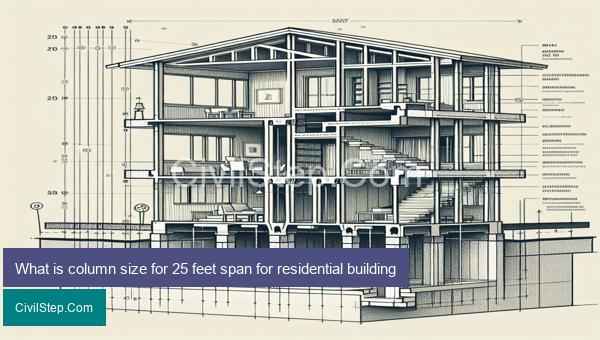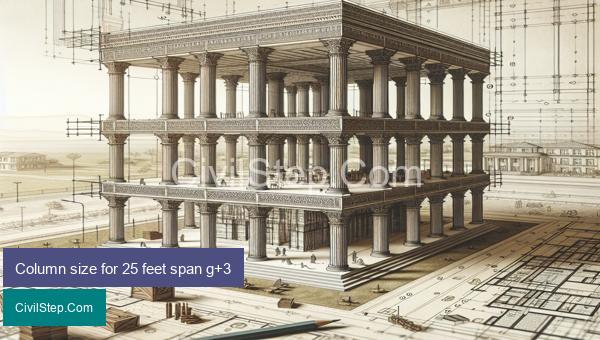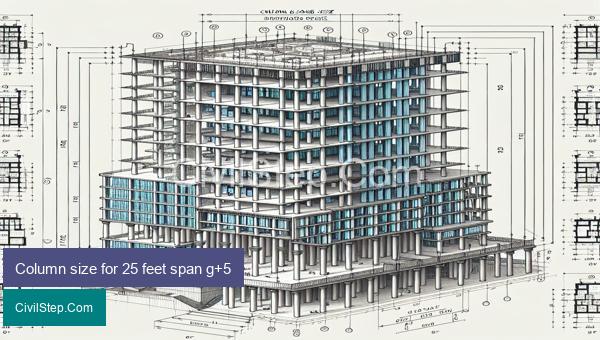
When it comes to constructing a residential building, one of the most important factors to consider is the column size. These structural elements play a significant role in supporting the load of the building and ensuring its overall stability. In particular, for a 25 feet span, the column size must be carefully determined to ensure the structural integrity of the building. In this article, we will delve into the various aspects of column size for a 25 feet span in residential buildings, including the factors that influence it, the different types of columns, and the recommended sizes for optimal construction. So, if you are planning on building or renovating a residential building with a 25 feet span, read on to find out all you need to know about column size.
What is column size for 25 feet span for residential building

Column size is a critical design parameter that plays a significant role in the structural stability and overall aesthetics of a residential building. In this article, we will discuss the appropriate column size for a 25 feet span in a residential building.
Before understanding the column size, it is essential to comprehend the purpose of columns and their role in a building’s structural system. Columns are vertical structural members that transfer the weight of the superstructure to the foundation, providing support and stability to the building. In a residential building, columns are responsible for carrying the load of the floors, walls, and roof.
The column size for a 25 feet span in a residential building primarily depends on the type of construction, the building’s number of floors, and the load it is expected to bear. For a residential building, the primary loads that a column has to withstand are gravity loads, such as dead load (weight of the structure itself) and live load (movable objects like furniture and people).
The minimum column dimension for a 25 feet span in a residential building should be 12 inches x 12 inches. However, this dimension can vary depending on the type of material used for construction. For instance, if the columns are made of RCC (reinforced cement concrete), the standard size for a 25 feet span would be 12 inches x 12 inches. On the other hand, if the columns are constructed using brickwork, the column size would be 9 inches x 9 inches.
Apart from the column size, the spacing of columns is also essential for a 25 feet span in a residential building. Ideally, the spacing between columns should not exceed 15 feet for residential construction. A larger column spacing can result in an inadequate transfer of loads to the foundation, causing structural instability and an increased risk of collapse.
It is also essential to consider the building’s number of floors while determining the column size for a 25 feet span. As the number of floors increases, more significant loads are transferred to the columns, requiring larger column sizes to bear the extra burden.
In addition to the structural requirements, the aesthetic aspect of the building should also be considered while deciding the column size. In a residential building, it is common to have larger living spaces, which can be achieved by reducing the number of columns. However, this should only be done after consulting with a structural engineer to ensure the safety and stability of the building.
In conclusion, the column size for a 25 feet span in a residential building depends on various factors, such as construction type, number of floors, and expected loads. To ensure a safe and stable structure, it is crucial to consult with a qualified structural engineer for the accurate determination of column size.
Column size for 25 feet span g+1

Column size is an important consideration when designing and constructing a building. It serves as the main support for the structure, carrying the weight of the building and transferring it to the foundation. For a span of 25 feet in a building with two floors (G+1), the column size needs to be carefully chosen to ensure the structural integrity and stability of the building.
The general rule of thumb for column sizing is that the column dimensions should be proportional to the span of the beam it supports. This means that the wider the span, the larger the column size should be. In addition to span, the type and strength of the materials used in construction, such as concrete and steel, also play a role in determining the column size.
For a 25 feet span in a G+1 building, the recommended column size would be around 12 inches by 12 inches for square columns or 14 inches in diameter for circular columns. This size is suitable for supporting the weight of a two-story building and ensuring proper load distribution to the foundation.
However, the actual column size may vary depending on other factors such as the type and design of the building, location and soil conditions, as well as the applied load on the column. It is important to consult a structural engineer to accurately determine the appropriate column size for a specific building project.
In addition to the size, the spacing of the columns also needs to be considered. For a 25 feet span, the recommended spacing between columns should be around 10 to 12 feet. This ensures that the load is evenly distributed and prevents any sagging or deflection in the beams.
In conclusion, when designing a building with a 25 feet span and two floors (G+1), the recommended column size would be around 12 inches by 12 inches for square columns or 14 inches in diameter for circular columns. However, it is important to consult with a structural engineer to determine the most appropriate column size and spacing for a specific building project to ensure its structural safety and stability.
Column size for 25 feet span g+2

When designing a building, one of the most important aspects is determining the right size for columns. Column size is crucial for providing structural stability and support to the building. For a 25 feet span g+2 building, the column size needs to be carefully calculated to ensure the safety and integrity of the structure.
The first step in determining the column size is to consider the building’s load-bearing capacity. This includes the dead load, which is the weight of the building itself, and the live load, which is the weight of occupants, furniture, and other dynamic loads. In this case, the live load for a g+2 building can be assumed to be around 150kg/m2.
The second factor to consider is the type of column that will be used. The two most common types of columns used in construction are concrete and steel. Concrete columns are typically more economical but require a larger cross-section than steel columns to support the same load. For a 25 feet span g+2 building, concrete columns can be chosen as they are more suitable for this type of structure.
Based on these factors, the column size for a 25 feet span g+2 building can be calculated using the following formula:
Column Size = (Live Load x Span)/ (Safe Load Capacity x Floor Area)
Assuming a safe load capacity of 6 metric tons per square meter and a floor area of 25 feet x 25 feet (7.62m x 7.62m), the column size would be:
Column Size = (150 kg/m2 x 7.62m)/ (6 metric tons/m2 x 58.04m2)
= 11,430 kgm/m2
= 1.14 kN/m2
From this calculation, we can determine that the column size for a 25 feet span g+2 building should be approximately 1.14 kN/m2. This size can be used for all the columns in the building, including the ones on the ground floor, the second floor, and the roof.
Another important factor to consider when determining column size is the spacing between the columns. It is essential to ensure that the distance between columns is not too large, as this can lead to structural instability and uneven load distribution. For a 25 feet span g+2 building, the spacing between columns should be around 4-5 meters to provide adequate support and stability.
In conclusion, determining the right column size for a 25 feet span g+2 building is crucial for maintaining structural integrity and safety. It requires careful consideration of the load-bearing capacity and type of column, as well as the spacing between columns. By following the calculation and considerations mentioned above, a suitable column size can be determined for a 25 feet span g+2 building.
Column size for 25 feet span g+3

As a civil engineer, one of our important tasks is to design and construct buildings that are structurally sound and safe for occupancy. In order to achieve this, proper column sizing is essential for the overall stability and strength of the building. In this article, we will discuss the appropriate column size for a building with a span of 25 feet and 3 floors (g+3).
First, we need to understand the role of columns in a building. Columns are vertical structural elements that support the weight of the building and transfer it to the foundation. They also resist lateral forces such as wind and earthquakes, ensuring the building’s stability.
While designing the column size for a building, we consider several factors such as the type of construction, the material used, the height of the building, and the span of the floors. In the case of a 25 feet span and g+3 building, the column size will depend on the load it will be carrying.
The load on a column is a combination of dead load (weight of the structure itself) and live load (occupancy, furniture, and other temporary loads). For a residential building with a span of 25 feet, the recommended live load is 50-70 pounds per square foot (psf).
Based on this live load, the column size for a g+3 building can vary from 9×9 inches to 12×12 inches for a square column and 10×12 inches to 12×15 inches for a rectangular column. These values are just approximations, and the actual column size may be different depending on the design calculations.
Apart from the load, the material used also plays a crucial role in determining the size of the columns. For example, if we use reinforced concrete (RCC) as the building material, the thickness of the column will be greater than if we use steel. This is because RCC has less compressive strength than steel, and therefore, needs to be thicker to support the same amount of load.
In addition to the above factors, the height of the building also affects the column sizing. As the building’s height increases, the load on the columns also increases, and therefore, larger and stronger columns are required.
To ensure the safety and stability of a building, it is crucial to follow the appropriate column sizing guidelines and conduct detailed structural analysis and design calculations. It is always recommended to consult a structural engineer for proper guidance on column sizing and structural design.
In conclusion, for a g+3 building with a 25 feet span, the appropriate column size may vary from 9×9 inches to 12×15 inches, depending on factors such as the load, material, and height of the building. As civil engineers, it is our responsibility to carefully consider all these factors and design structurally sound buildings that ensure the safety and well-being of its occupants.
Column size for 25 feet span g+4

When designing a building, one of the key factors to consider is the size of the columns. Columns are vertical structural elements that provide support to the floors and roof of a building. In this scenario, we will discuss the column size for a 25 feet span building with a total of four floors, also known as G+4.
The first thing to consider when determining the column size is the load that the column will be subjected to. This includes the weight of the floors, roof, and any additional load such as furniture, people, and other equipment. The type, height, and location of the building will also affect the load on the columns.
For a 25 feet span building, we can assume a load of about 10-15 kN/m2 for the floors and 7-10 kN/m2 for the roof. This will result in a total load between 170- 250 kN for each column. Since we are dealing with a four-story building, the load on each floor will be divided among the columns, reducing the load for each individual column.
The next factor to consider is the type of columns to be used. In this scenario, we will use reinforced concrete (RC) columns, which are commonly used for buildings. The size of the columns will depend on the type of reinforcement used, the amount of reinforcement, and the design code being followed. In this case, we will use the American Concrete Institute (ACI) design code.
Based on the ACI code, the minimum size for an RC column is 12 inches by 12 inches (300 mm x 300 mm). However, this size is recommended for small buildings with low seismic activity. For a four-story building with a 25 feet span, it is advisable to use slightly larger columns, such as 16 inches by 16 inches (400 mm x 400 mm).
The shape of the building’s floor plan also plays a significant role in determining the column size. In a building with a rectangular floor plan, the columns at the corners will experience higher loads due to the transfer of forces. Therefore, these columns may need to be larger in size to accommodate the increased load.
In addition to the above factors, the choice of foundation also affects the column size. If the building is located in an area with soft soil, the foundation will need to be larger, which will, in turn, require larger and stronger columns to support the building.
In conclusion, for a 25 feet span G+4 building, the recommended column size would be 16 inches by 16 inches (400 mm x 400 mm) for RC columns. However, it is essential to consider all the factors mentioned above and consult with a structural engineer before finalizing the column size for a building. A properly designed and sized column system will ensure the safety and stability of the building for its intended lifespan.
Column size for 25 feet span g+5

The size of columns for a 25 feet span g+5 building would depend on various factors such as the type of construction, load-bearing capacity, and the code requirements of the local authority. However, here are some general guidelines for column size that can be considered:
1. Type of construction: The type of construction plays a crucial role in determining the column size. For a g+5 building, the most common type of construction is reinforced concrete (RCC). In this type of construction, the columns are designed to resist both axial and bending loads.
2. Load-bearing capacity: The load-bearing capacity of a column is determined by three factors – compression, bending, and shear. The total load on a column is calculated by considering the weight of the building, live load (occupants, furniture, etc.), and the lateral forces such as wind and earthquake.
3. Code requirements: Every country has a specific code of practice for designing buildings, which specifies the minimum size of columns based on the type of construction, height of the building, and type of load. In India, the National Building Code (NBC) provides guidelines for column sizes based on the above factors.
Based on the above factors, the following are the recommended column sizes for a 25 feet span g+5 building:
1. For compression: The minimum size of a column should not be less than 9 inches x 12 inches (225 mm x 300 mm).
2. For bending: The minimum size of a column should not be less than 9 inches x 9 inches (225 mm x 225 mm).
3. For shear: The minimum size of a column should not be less than 9 inches x 9 inches (225 mm x 225 mm).
It is important to note that these are general guidelines and may vary depending on the specific design requirements and code provisions. Designers should consult with a structural engineer to determine the exact column size for the structural stability of the building.
In conclusion, the column size for a 25 feet span g+5 building should be carefully chosen based on the type of construction, load-bearing capacity, and the code requirements to ensure the safety and stability of the structure.
Conclusion
In conclusion, selecting the appropriate column size for a 25 feet span in a residential building is crucial for ensuring structural stability and safety. The size of the column depends on factors such as the type of building, load-bearing capacity, and the local building codes. Consulting a structural engineer and using advanced structural analysis software can help in accurately determining the optimum column size for your project. Properly sized columns not only ensure safety but also minimize construction costs and time. So, make sure to carefully consider all the factors when deciding on the column size for your 25 feet span residential building to achieve a strong and durable structure.
